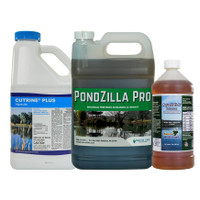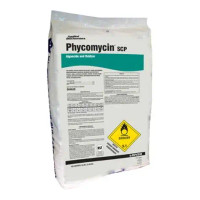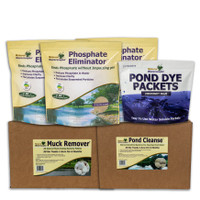-

Cutrine Plus Liquid Algaecide 1 gal $59.99Cutrine Plus Algaecide 1 gallon Cutrine Plus is designed to control bottom growing string algae / filamentous algae, green water / planktonic algae, and chara. EPA-approved for use in lakes and potable water reservoirs, farm fish ponds and...$59.99 -

Cutrine Plus Granular Algaecide 30 lb $139.99Cutrine Plus Granular Algaecide- our Best Selling String Algae Treatment Cutrine Plus Granular is designed to control bottom growing string algae / filamentous algae, and chara. Cutrine is simple to use. The granular chelated copper product...$139.99 -

Algae Control Pond Package $219.97 - $256.96{ "@context":"https://schema.org", "@graph":[ /* ===== WebPage (context) ===== */ { "@type":"WebPage", "@id":"https://shop.naturalwaterscapes.com/algae-control-pond-package/#webpage", "url":"https://shop...$219.97 - $256.96 -

Clean Pond Maintenance Kit 1/4 acre $509.97 - $655.97Clean Pond Maintenance Pack 1/4 acre pond 5 month supply for 1/4 acre pond The Clean Pond Maintenance Pack provides you with natural treatments to give you a healthier, and cleaner pond. Pond issues like murky water from suspended organics, smelly...$509.97 - $655.97 -

Clean Pond Maintenance Kit 1/2 acre $899.97 - $1,039.97Clean Pond Maintenance Pack for 1/2 acre ponds 5 month supply for 1/2 acre pond The Clean Pond Maintenance Pack provides you with natural treatments to give you a healthier, and cleaner water body. Pond ecosystem issues like murky water from suspended...$899.97 - $1,039.97 -

GreenClean Pro 50 lb Granular Algaecide $160.00GreenClean Pro Granular Algaecide & Bactericide Kills algae Kills cyanobacteria- filamentous and planktonic blue-green algae Immediate results Safer alternative to copper sulfate GreenClean Pro is a sodium carbonate peroxyhydrate based...$160.00 -

Cutrine Plus Granular Algaecide 12 lb $69.99Cutrine Plus Granular Algaecide - our Best Selling String Algae Treatment Are you looking for a product that will help control string algae in your pond? Cutrine Plus Granular is designed to kill bottom-growing string algae aka filamentous algae...$69.99 -

Hydrothol Granular Aquatic Herbicide & Algaecide 20 lb $139.99Hydrothol Granular Aquatic Herbicide AND Algaecide Hydrothol Granular acts as both an herbicide and algaecide, making it an excellent choice for pond owners. Hydrothol reacts quickly once applied to ponds with actively growing algae and weeds...$139.99 -

Pump Sprayer 3 gallon capacity $53.99Pond Weed & Algae Sprayer - 3 gallon Pump Sprayer In order to effectively apply most liquid aquatic herbicides and algaecides, you need to disperse the solution via sprayer. Spray weeds in the areas where they are actively growing. Pour chemical...$53.99 -

Phycomycin Granular Algaecide 50 lb $155.00Phycomycin® Non-Copper Algaecide Fast-Acting Algae and Cyanobacteria Control for Aquatic Environments Kills algae on contact Effective against cyanobacteria (blue-green algae – planktonic and filamentous) Immediate visible results...$155.00 -
 $29.99
$29.99 -

Blue Stone Crystals Copper Sulfate for Ponds $49.99 - $119.99Blue Stone Crystals Copper Sulfate for Ponds Use to kill all forms of algae Multiple treatment methods Copper sulfate is used to kill visible algae within ponds. Active ingredient: Copper Sulfate Pentahydrate* 99.0% *Metallic Copper...$49.99 - $119.99 -

Clean Pond Maintenance Kit 1 acre $1,879.99 - $2,242.97Clean Pond Maintenance Pack for 1 acre ponds 5 month supply for 1 acre pond The Clean Pond Maintenance Pack provides you with natural treatments to give you a healthier, and cleaner water body. Pond ecosystem issues like murky water from suspended...$1,879.99 - $2,242.97 -

GreenClean 20 lb Algaecide $94.99GreenClean Granular Algaecide – 20 lb Bucket Fast, Effective Control of Algae Blooms in Ponds, Water Gardens, Fountains, and Water Features GreenClean Granular Algaecide is a strong , non-copper algae treatment . This includes...$94.99
Algae control for ponds & lakes using targeted algaecide treatments.
Control Algae Blooms in Ponds
What is Algae?
Algae exist in water bodies of all sizes. They can be carried to water by birds, land animals, boats, fishing gear, and even the air.
There are different types of algae that can be found in ponds, including filamentous, planktonic, and macroalgae. Filamentous algae grows at the bottom of the pond and can appear as green mossy mats, slime, or long hair-like strands. Planktonic algae float freely throughout the pond and can have different colors such as green, yellow, blue-green, or brown.
Macroalgae, such as Chara and Nitella, are often mistaken for submerged weeds but are actually forms of algae.
Managing algae blooms in ponds is crucial to prevent water imbalances and protect fish populations from harmful water quality conditions. Algae require nutrients and sunlight to grow aggresively. Controlling sunlight by using pond dye and reducing excess nutrients with beneficial bacteria are effective management tools.
Filamentous
Pond owners commonly call filamentous algae string or hair algae. Growth begins at the bottom of the pond until it breaks free and floats to the surface in mats.
There are many species of filamentous algae so not all blooms will look the same.
String algae can look like green mossy mats, slime or long hair-like strands. The color of filamentous algae is normally bright green to dark green.
Pithophora is a type of filamentous algae that has a cotton-like consistency. Spirogyra feels like wet silky hair.
As string algae matures it eventually releases to the surface of the pond. Why does string algae float to the surface? It becomes buoyant from the oxygen it is producing.
Is string algae bad for a pond?
While filamentous algae may not be visibly appealing, it can provide some benefit to the pond when present in moderate amounts. It is a food source for invertebrates, protozoans, and fish.
If a bloom is covering the majority of the surface, this shows that excess nutrients are present. It is important to reduce nutrients levels within the pond or lake.
An algae bloom can create dangerous conditions for aquatic life in ponds and lakes. Algae produce oxygen through photosynthesis during daylight hours. They also consume oxygen 24 hours a day. At night, the algal bloom can use all of the available dissolved oxygen in the water causing a fish kill.
Similarly, using an algaecide creates dead plant matter that consumes oxygen and can also cause a fish kill. Pond Aeration can reduce the stress on aquatic life and limit the risk of fish kills.
Planktonic
Pond managers commonly refer to planktonic algal blooms as green water or pea soup. These single-celled Diatoms float freely throughout the pond. Coloration of planktonic forms can be green, yellow, blue-green or brown.
Planktonic blooms can be a sign of a serious imbalance in water. If the visibility in to the water column is less than 18 inches, you should take steps to improve water conditions.
Planktonic blooms produce oxygen during the day and consume oxygen at night. A heavy planktonic bloom can result in a fish kill from oxygen uptake at night. These kills can also occur when there are consecutive overcast days. Without sun, planktonic blooms consume oxygen during the day instead of producing it.
Chara & Nitella
Chara and nitella are types of macro-algae. They are commonly misclassified as submerged weeds but are forms of algae. People also know Chara as muskgrass because of its strong odor.
Chara produces stems with leaves growing in whorls around the stems. There is a gritty calcified outer coating. Chara has a skunk-like odor. It is typically found in hard water.
Nitella has similar looking growth to chara but lacks the gritty calcified coating and has no odor. Nitella, typically found in acidic or soft water, is also more delicate than chara.
There is no root system with macroalgae forms.
Algae Control for Ponds
Effective controls for algal blooms include pond algaecides, pond dye, and beneficial bacteria to reduce excessive nutrients in the water.
Granular algaecides can be utilized to prevent and treat filamentous blooms by focusing on the growth at the bottom of the pond. After the mats have begun to float to the surface, liquid algaecides should be used to gain control.
Pond dye is an effective control when used consistently to block sunlight from reaching the pond bottom.
Reducing excess Nitrogen and Phosphorus in the water column is also a very effective preventative. Beneficial bacteria digest Ammonia, Nitrate, and Nitrite in the water and release it to the atmosphere as Nitrogen gas.
